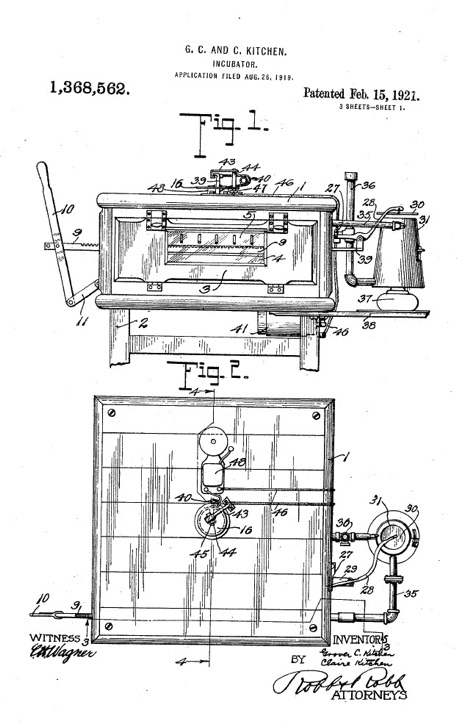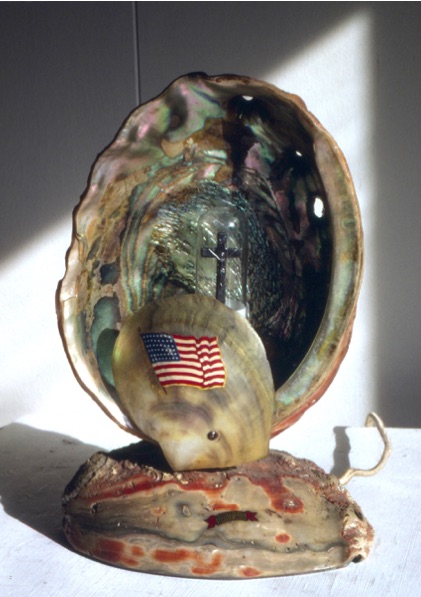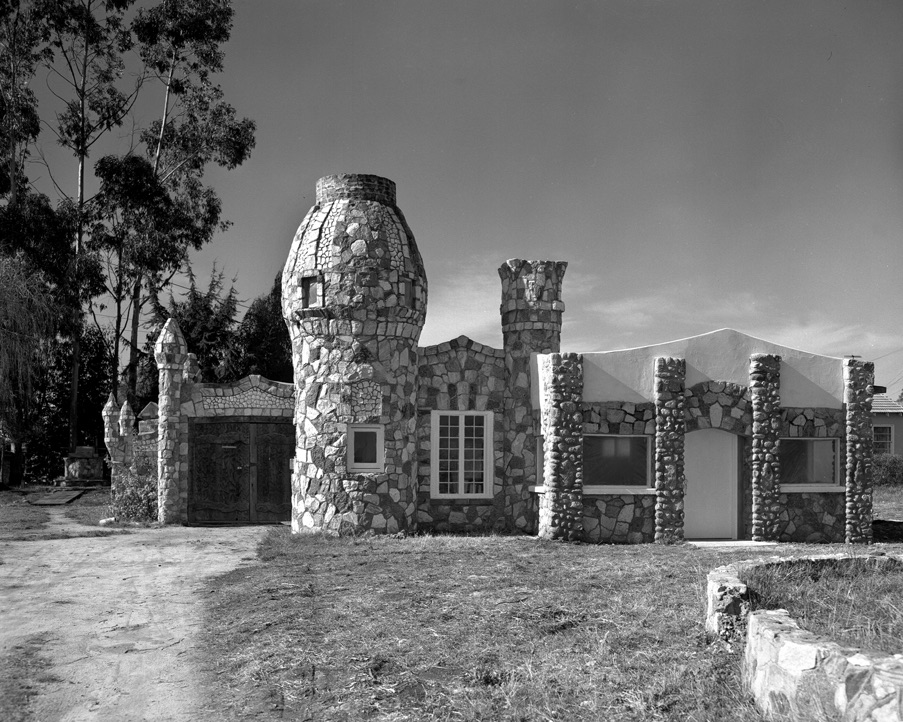Court of Mysteries
A New Life For The Court Of Mysteries
Since its inception as a tourist destination in the late 1800s, Santa Cruz, California has long been the scene of multiple tourist attractions and eccentric residents. It is most famously known for its historic beach boardwalk located along Monterey Bay, the world famous big dipper rollercoaster, old penny arcade and the Mystery Spot. More unconventional attractions such as Santa's Village in the 1950s and the Tree Circus (1947), along with the city's natural beauty as a seaside resort, have also helped to draw multitudes of visitors to the area over the years.
Yet another lesser-known attraction, "The Court of Mysteries," has long been a part of the town's western edge and, outside of local residents, little known to others except those drawn to offbeat roadside attractions and folk art sites. "The Court of Mysteries" was constructed by an eccentric self-described "Master Stone Mason" named Kenneth Claire Kitchen, along with his "Artistic Brick Mason" brother, Raymond. The two artisans employed their masterful skills and excellent attention to detail in the concrete reinforced complex's design and again when constructing a second unnamed building as a home for Raymond on a separate lot some distance down the long street.
Kenneth Claire Kitchen was born into a large farm family in Five Points, Pennsylvania in 1894. His father, William Kitchen, and mother, Sarah Jane, had 11 children. William also had 11 children with his first wife, Hannah. The large family eventually moved from Pennsylvania and settled in Fredrick, Kansas where they are listed as residents in the 1910 U.S. Census. While residing in Kansas in 1919, Claire and his brother, Grover, applied for the first of three patents the pair would eventually be awarded, the first being for an improved Incubator. Claire and Grover arrived in California in 1923 and, after a brief stay in the town of Sonoma, applied for their second patent for their Egg Turning Means For Incubators. And, in December of that year, while living in Santa Cruz, they applied for their third and final patent for a Molding Form For Cement Bricks. By that time, several of their siblings were living in the area and working in the building trades. In 1929, their brother, Raymond, joined them in Santa Cruz.

Enter Text
Kenneth and Grover's Patent drawing for an Incubator, 1921.
By 1934 Claire and Raymond each purchased a lot on Fair Avenue after the brothers were evicted from a building that Claire owned at the time. Soon after first moving to the new property, Claire began to utilize the large field in front to keep his herd of goats and then built a wooden goat barn along the back of the lot. Ever the entrepreneur, Claire produced goat's milk products that he sold to the public. Eventually he constructed his "Scriptorium" behind the barn to keep his collection of books on Eastern mysticism and to house his architectural studio.
Claire's inspiration for creating the fantasy building complex and the purpose it was to serve has been the subject of much speculation over the years. Most of the information forthcoming, however, has been based on recollections, rumors and hearsay from neighbors and acquaintances, so the real story behind it may never be completely known. One account often related is regards to his amorous intentions towards the daughter of a local pharmacy owner. In this version, he was said to have constructed the building to win the young lady's heart, but in the end, however, she turned down his advances. Another version traces his inspiration to a long fascination with Eastern mysticism that he is credited with having been introduced to while serving in the military during WWI in Turkey. He is also said to have learned his building profession there as well.
The Gate of Prophecy, 1935.
While Kitchen was never known to have called the building, "The Court Of Mysteries," he did refer to it as "Unit #1" of a "Yogi Temple" when applying for a building permit in 1946 for construction of the main building. Today, the building is also known to locals by several names such as The Watts Towers of Santa Cruz, The Red Palace and The Yogi Temple. Yet the story of the entire complex is an engaging one of a folk artist and inventor who only possessed an eighth-grade education and created a masterfully produced labor of love that was eventually to take on a second function in a time of war leading to more speculation and intrigue.
Abalone shell mosaic lining the interior arch of the Gate of Prophecy.
Detail of the top of a tower, Gate of Prophecy
View of the fence running alongside of the street.
Abalone cap on a brick fence support column.
In 1935 he began working on the fence along the street side of the property with the "Gate of Prophecy" as the main entrance at its center. The fence leading to the gate is made of reinforced cast cement sections interspersed with brick support columns capped with abalone shell mosaic tops. The gate is an elaborate structure composed of four brick towers with two shorter ones at either end of a low brick wall that is also topped with an abalone shell mosaic surface. Originally all four towers were illuminated at night. Above the center of the entryway arch is a hovering triangular bas-relief supported by two abalone mosaic wing like forms at its center. Within the triangle is a circular abalone and cement motif depicting four stars, a crescent moon at 12 o'clock and a sun symbol at 6 o'clock. Interesting, also, is an abalone golden spiral in the center of the circular motif.
Triangular bas-relief plaque at the top of The Gate of Prophecy.
The same triangular motif was repeated on a second plaque (now destroyed) above the mantel of the fireplace in the temple's interior when it was constructed some years later. Claire believed the symbols contained within both plaques were dynamic and when they aligned there would be an apocalypse followed by what he called an "Age of Peace."
All of this original construction of the complex appears to be a combined effort on both brothers' parts as it exhibits a high degree of sophistication and craftsmanship required of both a stone and brick mason. While the brothers remained close, they were known around town as frequently engaged in arguments and fights that often ended up in fisticuffs. Many neighbors as well as other acquaintances described the pair as "a little off" or "touched" when reflecting on their personalities.
It has been reported by several sources that the Kitchen brothers' construction was all undertaken without the burden of building permits and that they worked only at night using lanterns and moonlight for illumination. Whether working at night in the dark had any mystical connotations for them is unknown. But since they both worked for a living, this may in fact have been the only time they had to work on their buildings. Regarding their lack of building permits, official records reflect that the brothers did in fact both apply for building permits and as tradesmen would be more than aware of the requirement to do so. Claire applied for a permit for his Unit #1 for his "Yogi Temple" as noted earlier in 1946 and Raymond applied for his permit in 1947.
Another non-conventional aspect the brothers are said to have employed as related by witnesses was that Claire used a luxury car and, depending on the source, either a Cadillac, a Rolls Royce or a Packard to transport stones from his source at Boulder Creek and bricks he made or acquired elsewhere to the site. Both brothers were also able to secure a large and continuous supply of abalone shells required for their constructions' embellishments from a processing plant in town, no doubt attracted by the beautiful Mother of Pearl surface of the shells that gave the property a luminescence otherwise unobtainable.
Abalone-Shell Totem Poles by "Lefty" Arndt. Made of over 400 shells and telephone poles.
The use of abalone shells in artistic embellishment can often be found in coastal areas where the edible sea snail was once plentiful. Today, however, their use has fallen into decline as they are endangered due to overharvesting and disease. Another striking example of the shells' artistic use can be found at the famous Arndt Abalone-Shell Totem Poles of Point Reyes Station, California. The over 30- foot towers topped by plastic owls have been one of the small town's most endearing landmarks for many years. There are many examples, too, of other folk artists whose works feature seashells, and many kitchy tourist souvenirs are made of them as well. But no one has every handled abalone more sensitively or artistically than the Kitchen brothers as evidenced by their use at "The Court of Mysteries" and at Raymond's home.

La Tour Eiffel, folk art sea shell construction. Photograph by the author with permission of the Esse Purse Museum.
Abalone Shell folk art souvenir with Jesus lamp. Collection of the author.
Pump house where the secret submarine stopping device mechanism was submersed, 1936.
By 1936 Claire began to work on a brick pump house building to enclose his well. On top of the building he placed four illuminated minarets at its corners that unfortunately would be destroyed by a vandal in the 1990s. This structure would later become an essential part in his creation of a mysterious and secret "anti-submarine stopping device" perhaps as early as 1939 when the U.S. entered WWII in Europe, when he was said to have voiced his concern about being able to detect German submarines. In any case, shortly after the attack on Pearl Harbor in December of 1941, nine Japanese submarines did arrive along the Pacific Coast to take up positions with the intent of attacking and sinking merchant shipping and proceeding to do so between December 18th and the 24th of that year. Claire had responded to the omniscient threat to the coastal community by creating and utilizing his secret device consisting of a buried spoked railroad tie wheel in the front of the property followed by the construction of two tall towers at either end of his large field. His plan called for one tower to receive radio signals from submarines and the other to send out signals to interfere with their communications. A mysterious part of the device was the submersion of its mechanism in the pump house well. Claire claimed he could hear communications and, to remain alert, neighbors told of his hosing down his mattress every night so he would stay awake to listen for signals. The device and his odd behavior – along with the rumor that the brothers were spies - evidently was the subject of much neighborhood speculation.
Submarine interference antenna on the south side of the property, 1940s.
Submarine interference antenna on the north side of the property, 1940s.
Japanese subs did operate in the area. The sub, I-23 under the command of Captian Genichi Shibata, ran across the Richmond Oil tanker, Agwiworld, commanded by Captain Frederick Goncalves and, after stalking her, attacked when she was 20 miles off Cypress Point in Monterey Bay. The attack and pursuit was witnessed by many from shore as the ship made for a safe anchorage towards Santa Cruz. Shibata's faster submarine failed to sink the tanker by being outmaneuvered by Captain Goncalves and gave up the pursuit when it overheard the ship's radio distress call to the U.S. Navy for assistance. No doubt this exciting and widely reported local event greatly influenced and inspired Kitchen. The I-23 departed Monterey Bay on December 22nd headed for the Palmyra Island area of the South Pacific. She, along with all 96 hands on board, was later lost to an unknown cause on February 28, 1942 off the Oahu coast of Hawaii. By the 24th of December, the subs had attacked a total of eight ships, damaging two and sinking two while killing a total of six seamen.
Once the U.S. Navy began experiencing problems with their subs in the area and after learning of Kitchen's secret device, neighbors reported that he was detained by the Navy and shipped off to Florida. Some claim that the Navy broke into the pump house and stole his secret plans. After his return from Florida, Kitchen continued to work on his two-story Yogi Temple to be topped by a dome from 1946 until the mid 1950s when, after only completing the first story, he suddenly left the area never to return. He died in 1960 at the Warren State Psychiatric Hospital in Warren, Pennsylvania with his body being donated to science.
"Unit #1 of the Yogi Temple," 1946.
After his departure, "The Court of Mysteries" sat vacant and abandoned until the late 1960s when it was sold to a Greek Orthodox minister who converted it into the St. Elias Greek Orthodox Chapel and Shrine that locals call the "Unorthodox Chapel." Eventually, the church abandoned the property and by the 1990s it was considered a nuisance and listed for demolition. It is important to note that both brothers wanted their buildings to be lasting and that even the 1989 Loma Prieta earthquake, that destroyed much of downtown Santa Cruz, had no discernable effect on the structural integrity of either building. Fortunately, recognizing the value of the idiosyncratic and historical site, a group of neighbors and a local architect were able to save the building. A caretaker was hired to thwart vandals and took up residence in a trailer and "The Court of Mysteries" was listed for sale at $2.2 million dollars.
The now historic property recently sold to a San Francisco couple for $1.58 million. The new owners have expressed an interest in restoring it and opening it for tours. So perhaps in the not too distant future the public will at last be able to gain access to one of Santa Cruz's most enduring and ongoing mysteries.
Unfortunately, the same cannot be said for brother Raymond's house known to locals as "Kitchen's Castle." The "artistic brick mason" as he referred to himself, began his concrete block home with its signature bulbous style fireplace in 1947. The fireplace was said to be the largest in Santa Cruz at the time, so big in fact that a later owner converted it into an office. Some years later Raymond told the then owner that he was inspired for his design by a postcard he had received from India. He has also been credited with excavating a mysterious "complex water system" under the building that in fact was part of a decorative pond whose water system ran beneath the building.
The home was never completed by the time Raymond and his wife departed the small town in1949 when they moved to California's Central Valley. Eventually, the building's third owner, Walter J. Irby, a carpenter, completed the building around 1953 before selling it to Dr. B.B. Stoller, owner of a fertilizer manufacturing company in the mid 1950s. Stoller converted the former home into an office and added additional structures to the property. He operated his business there until 1992. The building remained on the site until 2012 when it was demolished.
Today, "Kitchen's Castle" is known only from existing photographs showing a visually complex Gaudiesque building covered with an elaborate abalone shell and decorative stone mosaic.

Kitchen's Castle, 1947. Demolished in 2012. Photograph with permission of Covello and Covello Photography.
All photographs were taken by the author unless noted otherwise.
© 2016 Phil Pasquini all rights reserved worldwide
Sources:
Chase, John Leighton. The Sidewalk Companion to Santa Cruz Architecture.
Santa Cruz, California. The Museum of Art and History. 2007.
Covello and Covello Photography
Photo archive
303 Potrero St. #40-D
Santa Cruz, CA 95060
1510 S Main St, Little Rock, AR 72202
(877) 918-2302
State of California – The Resources Agency
Department of Parks and Recreation
Primary Record – DPR 523A (1/95)
Rev 1994
Titled: Aloha Medicinals
Retaining wall with Abalone Shell decoration. Pacific Grove, California.
Abalone Shell planting bed border. Monterey, California.